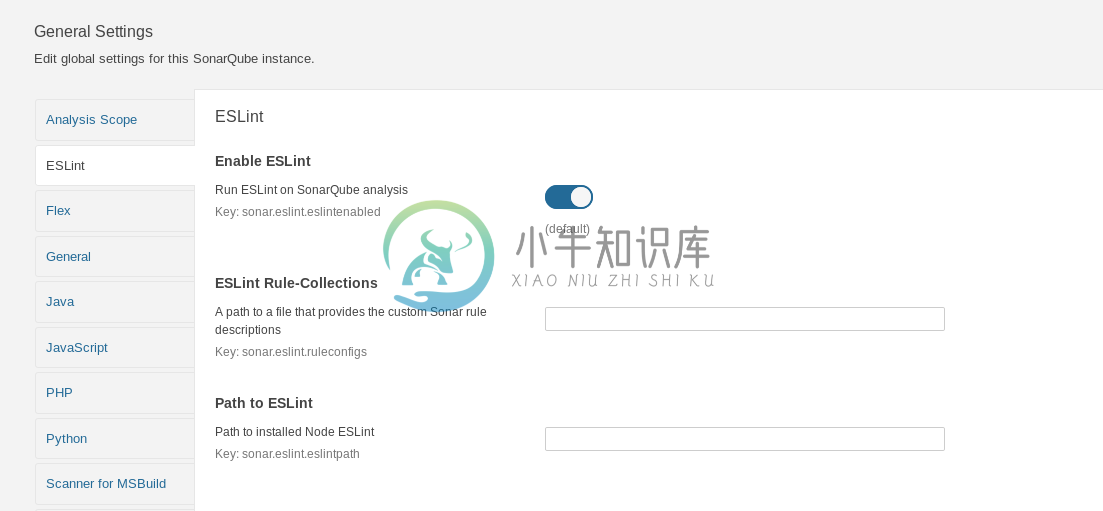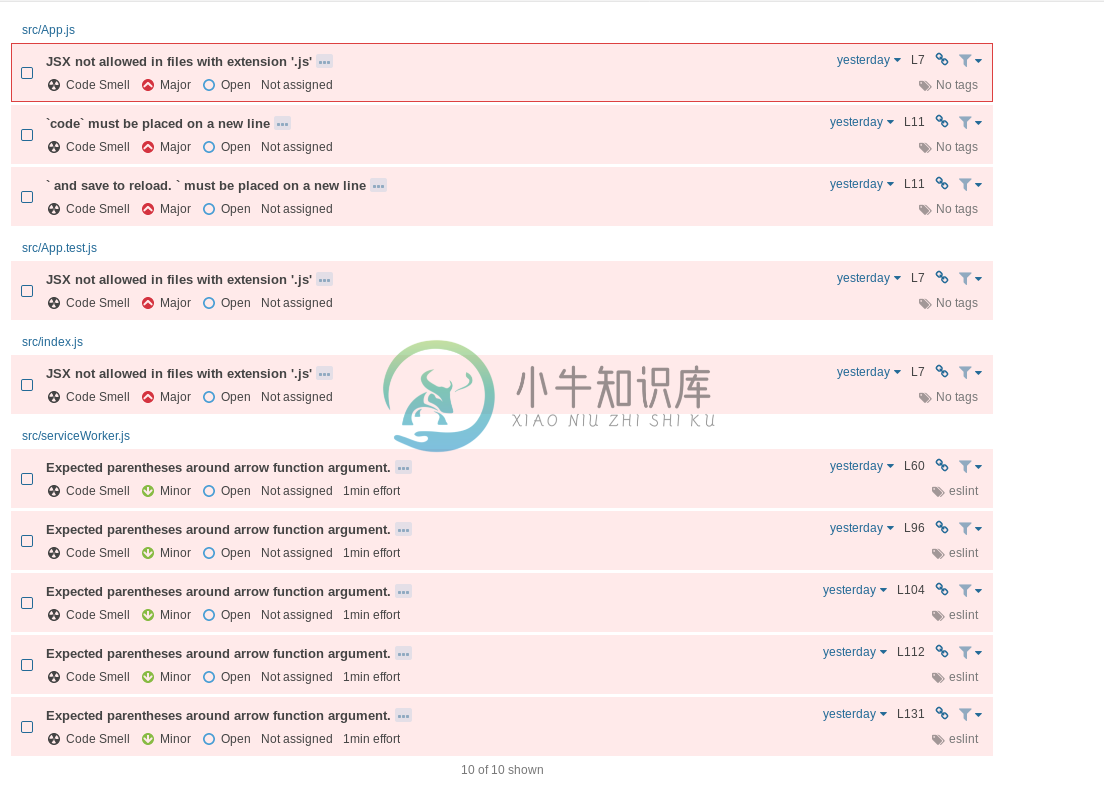==========================SonarEsLintPlugin
SonarQube plugin for EsLint linter and its extensions. The code is based on the Eslint plugin published by sleroy. https://github.com/sleroy/SonarEsLintPlugin
Download the plugin.
Basically this plugin joins the EsLint static analysis of the sleroy plugin with the description improvement of lint issues made by rochejul. Also adds new quality rules and updating some severities.
It seems that SonarJS now supports the import of an eslint result.json:https://docs.sonarqube.org/display/PLUG/Importing+ESLint+Issues+Reports
This plugin will not receive updates now.
Why we forked
This fork was initially necessary to change some severities and add new rules.
We don't have plans to add those changes in the original plugin, but if we create new feats we intend to send to it.
Changelog
0.3.5 - Added flag to --no-inline-config into the Plugin Settings
0.3.4 - Modified the ESLint plugin to deal with issues that registers line as 0
0.3.3 - Added ESLint rules to disable-inline plugin
0.3.2 - Added --no-inline-config to the eslint arguments, ensuring that even the eslint-disable comments will beregistered
0.3.1 - Add eslint url on issue description and modify Natura quality rules severity evaluates
0.3.0 - Upgrade to the latest Sonar API and dependencies and fix an issue (#2) when ESLint is meeting parsing errors or simply ignoring files.
- SonarQube API 6.7
0.2.0 - Upgrade to the latest Sonar API and dependencies :
- GSON 2.8.2
<sslr.version>1.22</sslr.version>- SonarQube API 6.5
Overview
This is plugin for SonarQube 6.7 for analysing projects with Javascript content that supports:
- EsLint for code quality information
- EsLint AngularJS extension
Notice : The plugin is known to not work with SonarQube 7.+ since the latest version of SonarQube has made significant changes on the Plugin API. I am working on it.
Notice: if you disagree with the severity evaluation of the EsLint rules inside SonarQube that I provided, please send a P/R on the file eslint-rules.properties.
It's presented only for the interested, and the brave.
Requirements
- Java 1.8+
- SonarQube 5.6 LTS+
- EsLint 3+ (Tested on 3.14)
Installation
- Install Node.js
- Install EsLint (3+) with
npm install -g eslint, or ensure it is installed locally against your project- If you're installing globally, find the path to EsLint and copy it - will be similar to
C:\Users\\[Username]\AppData\Roaming\npm\node_modules\eslint\bin\eslint.json Windows
- If you're installing globally, find the path to EsLint and copy it - will be similar to
- Copy .jar file (from
target/after build, or downloaded from Releases page) to SonarQube extensions folder - Restart SonarQube server
- Browse to SonarQube web interface, login as Admin, hit up Settings
- Hit the Rules tab, then the EsLint rule set, then apply it to your project - alter rule activation as required
Optional steps :
Find the Javascript tab, paste in the Javascript path
Make sure you have a
.eslintrc.*file next tosonar-project.properties, or specify its path using thesonar.eslint.eslintconfigpathsettingIf LCOV data available, add sonar.ts.lcov.reportpath=lcov.dat to your sonar-project.properties file (replace lcov.dat with your lcov output, will be sought relative to the sonar-project.properties file)
Run
sonar-runnerorsonar-scannerEsLint rule breaches should be shown in the web view
EsLint installation and configuration
By default, SonarEsLintPlugin will look for a version of EsLint installed locally within your project (i.e. in node_modules\eslint\bin), relative to the sonar-project.properties file. This may not be what you want, so you can set this directly via the sonar.eslint.eslintpath configuration setting:
- At project level
- Globally, for all projects
If analysis is failing, run sonar-runner with the -X -e options for more diagnostic information, including a note of where the plugin is searching for eslint. Bear in mind that if running on a build server, the account running the build will need access to the path to eslint.
By default, SonarEsLintPlugin will look for a EsLint configuration file called eslint.json next to the sonar-project.properties file. You can override this using the sonar.eslint.eslintconfigpath configuration setting if this isn't the case for your project.
Here an configuration example for .eslintrc.json
{
"extends": ["angular", "eslint:recommended"]
}
Configuration
Example project configuration
This is an example of what a project configuration file (sonar-project.properties) could look like:
sonar.projectKey=company:my-application
sonar.projectName=My Application
sonar.projectVersion=1.0
sonar.sourceEncoding=UTF-8
sonar.sources=src/app
sonar.exclusions=**/node_modules/**,**/*.spec.ts
sonar.tests=src/app
sonar.test.inclusions=**/*.spec.ts
sonar.eslint.eslintconfigpath=eslint.json
- See the Analysis Parameters documentation page for general configuration options.
- See the Narrowing the Focus documentation page for configuration options related to which files to include.
- See the rest of this README for the SonarEsLintPlugin specific configuration options.
Global configuration options
| Key | Description | |
|---|---|---|
| sonar.eslint.eslintpath | Recommended | Path to the installed copy of EsLint to use - can also be set at project level, see note below |
| sonar.eslint.ruleconfigs | Optional | A list of configurations to map custom EsLint rules to dedicated SonarQube rules & settings - see EsLint Custom Rules section below |
Project-level configuration options
| Key | Description | |
|---|---|---|
| sonar.eslint.eslintpath | Recommended | Path to the installed copy of EsLint to use - see note below |
| sonar.eslint.eslintconfigpath | Recommended | Path to the eslint.json file that configures the rules to be used in linting - see note below |
| sonar.eslint.excludetypedefinitionfiles | Optional | Excludes .d.ts files from analysis, defaults to true |
| sonar.eslint.forceZeroCoverage | Optional | Forces code coverage percentage to zero when no report is supplied, defaults to false |
| sonar.eslint.ignoreNotFound | Optional | Don't set code coverage percentage to zero when file is not found in report, defaults to false |
| sonar.eslint.eslinttimeout | Optional | Max time to wait for EsLint to finish processing a single file (in milliseconds), defaults to 60 seconds |
| sonar.eslint.eslintrulesdir | Optional | Path to a folder containing custom EsLint rules referenced in eslint.json |
EsLint Custom Rules
The plugin is shipped with the default ESLint rules. However you may want to use additional rules or some plugins with your ESLint configuration.
Notice : Both additional rules (located in a rules dir) and plugins requires a Sonar rule description. Without the Sonar rule description, the ESLint results cannot be imported.
How to use additional rules.
ESLint command CLI is offering this possibility :
--rulesdir [path::String] Use additional rules from this directory
This functionality is also offered by the SonarQube plugin.
To present custom EsLint rules in SonarQube analysis, you can provide a configuration that maps the EsLint rules from your sonar.eslint.eslintrulesdir directory to dedicated Sonar rules for analysis.
How to use ESLint plugins
Updates your .eslintrc configuration with your favorite plugins.
Then you need to provide the Sonar rule descriptions.
How to add Sonar rule descriptions
By default the ESLint SonarQube plugin is loading a default set of rules defined here :
As you can see, for each rule of Eslint, you have to define a set of properties to populate the Sonar Javascript profile. Without these informations the new rules are not being imported.
The plugin cannot dynamically add rules from ESLint since it is not supported by SonarQube. Rules have to be defined and loaded at the SonarQube startup.
How to add the eslint plugin extra rules ?
a) Fork the file eslint-rules.properties and send me the modifications to merge
The plugin will integrate the new rules for the other users.
b) Provides an additional sonar rule definitions by providing a link
The configuration for a EsLint Sonar rule consists of a line declaring the EsLint rule id, a boolean switch to enable or disable the rule if neededand some attached properties that are used by Sonar for analysis and reporting.
For example taking the export-name rule from the tslint-microsoft-contrib package,a configuration for that rule in SonarEsLintPlugin could look as follows:
rule-name=true
rule-name.name=The name of the exported module must match the filename of the source file.
rule-name.severity=MAJOR
rule-name.description=This is case-sensitive but ignores file extension. Since version 1.0, this rule takes a list of regular expressions as a parameter. Any export name matching that regular expression will be ignored.
rule-name.debtFunc=LINEAR_OFFSET
rule-name.debtScalar=15min
rule-name.debtOffset=1h
rule-name.debtType=HARDWARE_RELATED_PORTABILITY
You will need to restart the SonarQube server after configuring custom rules this way before subsequent analyses will pick them up. You will also need to activate the new rules after restart for any quality profile you want them to participate in - by default they will be disabled.
- For documentation about the
technical debtparameters look here and here - For possible values for
debtTypego here
What is happening when an ESLint rule is not documented into the Sonar plugin
Important : when a rule from an ESLint plugin is detected by the plugin, I am assigning the ESLint violation to the rule "Unknown rule" like in the caption below :
Therefore unless you provide the proper definition for this rule, you will have several violations with this description :
Licence
MIT
Building
- Download the source
- Build with maven, mvn clean && mvn install
Contributors
Thanks to the following for contributions to the plugin:
- Paul O'Neill For the original plugin for typescript
- Sylvain Leroy For the original plugin for eslint
- Julien Roche For the patches to add eslint rules descriptions






